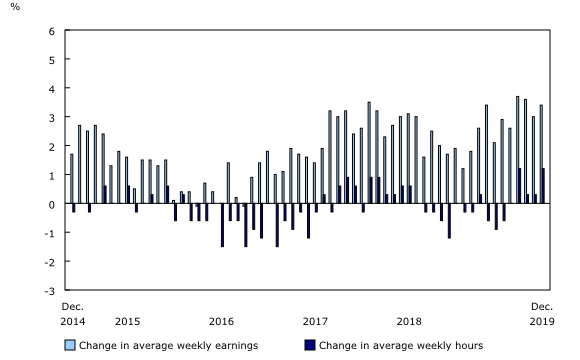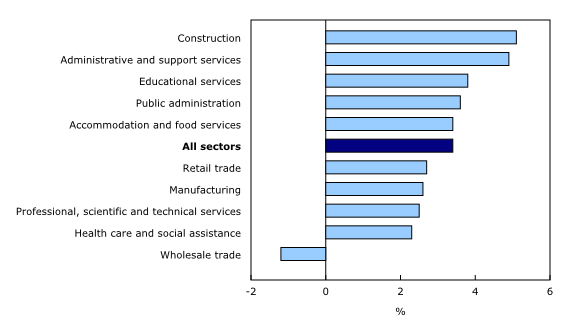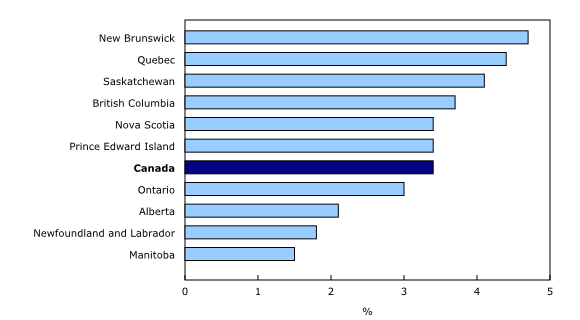Payroll employment, earnings and hours, December 2019
Archived Content
Information identified as archived is provided for reference, research or recordkeeping purposes. It is not subject to the Government of Canada Web Standards and has not been altered or updated since it was archived. Please "contact us" to request a format other than those available.
Released: 2020-02-27
$1,042.39
December 2019
3.4% 
(12-month change)
$1,068.35
December 2019
1.8% 
(12-month change)
$873.78
December 2019
3.4% 
(12-month change)
$919.77
December 2019
3.4% 
(12-month change)
$963.60
December 2019
4.7% 
(12-month change)
$986.67
December 2019
4.4% 
(12-month change)
$1,062.80
December 2019
3.0% 
(12-month change)
$953.69
December 2019
1.5% 
(12-month change)
$1,051.60
December 2019
4.1% 
(12-month change)
$1,165.99
December 2019
2.1% 
(12-month change)
$1,011.93
December 2019
3.7% 
(12-month change)
$1,178.75
December 2019
2.8% 
(12-month change)
$1,467.41
December 2019
3.1% 
(12-month change)
$1,479.22
December 2019
13.9% 
(12-month change)
The average weekly earnings of non-farm payroll employees were $1,042 in December, little changed from November. On a year-over-year basis, earnings grew 3.4%, the effect of an increase observed from March to October.
In general, changes in weekly earnings are the result of a number of factors, including wage growth; changes in the composition of employment by industry, occupation and level of job experience; and average hours worked per week.
Non-farm payroll employees worked an average of 32.9 hours per week in December, little changed from November. Compared with December 2018 (32.5 hours per week), average hours worked increased.
To explore the most recent results of the Survey of Employment, Payrolls and Hours in an interactive format, visit the "Earnings and payroll employment in brief: Interactive app."
Earnings grow in almost all large sectors
On a year-over-year basis, average weekly earnings grew in 9 of the 10 largest industrial sectors (in terms of employment), led by construction. There was little change in wholesale trade. Earnings also increased in smaller sectors such as utilities, finance and insurance, information and cultural industries as well as transportation and warehousing.
Payroll employees in construction earned an average of $1,310 per week in December, up 5.1% year over year. This rise, which was spread across almost all provinces, reflected increases in specialty trade contractors and construction of buildings.
Average weekly earnings in administrative and support services rose 4.9% year over year to $872, continuing an upward trend that started in August. The rise was primarily due to investigation and security services as well as services to buildings and dwellings. At the provincial level, Quebec contributed the most to the rise.
In educational services, earnings rose 3.8% to $1,100, mainly due to Ontario and British Columbia. Growth at the national level was widespread across the sector.
Compared with 12 months earlier, earnings in public administration were up 3.6% in December, to $1,363. At the national level, the rise in earnings was primarily due to the local, municipal and regional public administration subsector.
In accommodation and food services, average weekly earnings rose 3.4% year over year to $424.
Year over year, weekly earnings in retail trade increased 2.7% to $626 in December. General merchandise, clothing and clothing accessories, and food and beverage stores contributed to the rise which was tempered by a decline in motor vehicle and parts dealers.
Payroll employees in manufacturing earned an average of $1,159 per week in December, up 2.6% year over year. The increase was driven by transportation equipment manufacturing.
Compared with December 2018, weekly earnings in professional, scientific and technical services were up 2.5% to $1,445. The increase was led by computer systems design and related services as well as architectural, engineering and related services.
Among smaller sectors, earnings notably increased in transportation and warehousing (+4.5% to $1,113), mostly due to an increase in air transportation.
Earnings up in all provinces
Compared with 12 months earlier, average weekly earnings rose in all provinces in December, most notably in New Brunswick and Quebec.
Year over year, weekly earnings in New Brunswick grew 4.7% to $964. Earnings in the province have been on an upward trend since March. The year-over-year increase was driven by educational services and health care and social assistance.
Average weekly earnings in Quebec increased 4.4% to $987 in December. The earnings growth was spread over several sectors, with health care and social assistance as well as construction contributing the most to the rise.
On a year-over-year basis, earnings in Saskatchewan grew 4.1% to $1,052 and the growth was spread across multiple sectors.
Payroll employees in British Columbia earned an average of $1,012 per week in December, up 3.7% from 12 months earlier. The rise was primarily due to health care and social assistance as well as educational services.
Payroll employees in Nova Scotia earned an average of $920 per week in December, up 3.4% year over year. Finance and insurance as well as educational services contributed the most to the rise. Earnings in the province have been trending upward since mid-2018.
Compared with 12 months earlier, earnings in Prince Edward Island were up 3.4% in December, to $874. Health care and social assistance contributed the most to the rise.
In Ontario, earnings rose 3.0% year over year to $1,063. Earnings growth was spread across several sectors, with finance and insurance contributing the most to the rise.
Weekly earnings in Alberta were up 2.1% on a year-over-year basis, to $1,166 in December. Construction and finance and insurance contributed the most to the earnings growth.
On a year-over-year basis, slower growth was observed in Newfoundland and Labrador (+1.8%) and Manitoba (+1.5%).
Payroll employment virtually unchanged in December
The number of payroll employees was virtually unchanged in December compared with November. Decreases were recorded in a number of sectors, including manufacturing, retail trade and educational services. A notable increase was observed in health care and social assistance.
Payroll employment declined in Ontario and Manitoba, increased in Quebec and Prince Edward Island, and was little changed in the other provinces.
Employment growth in several services sectors since December 2018
Year over year, the number of payroll employees increased by 280,200 (+1.7%) in December. Employment grew in most sectors, led by health care and social assistance (+68,500 or +3.4%), professional, scientific and technical services (+40,600 or +4.3%) as well as educational services (+39,700 or +3.0%). Payroll employment also grew in every province, led by Quebec and Ontario.
In Quebec, the growth (+99,800 or +2.7%) was spread across multiple sectors with the largest gains recorded in health care and social assistance, educational services and public administration.
From December 2018 to December 2019, employment in Ontario grew by 94,600 (+1.4%) with the largest increases recorded in professional, scientific and technical services as well as health care and social assistance.
Payroll employment gains in British Columbia (+42,600 or +1.8%) were largely due to health care and social assistance, educational services and public administration.
There were more payroll employees in Alberta (+16,800 or +0.8%), the result of gains in health care and social assistance.
Sustainable Development Goals
On January 1, 2016, the world officially began implementation of the 2030 Agenda for Sustainable Development—the United Nations' transformative plan of action that addresses urgent global challenges over the next 15 years. The plan is based on 17 specific sustainable development goals.
The Survey of Employment, Payrolls and Hours is an example of how Statistics Canada supports the reporting on the Global Goals for Sustainable Development. This release will be used to measure the following goals:


Note to readers
With the March 27 release of January 2020 estimates, seasonally adjusted data will be revised based on the latest seasonal factors. Estimates will be revised historically back to 2001. Historical revisions will also be made to a small number of industries by province or territory.
The key objective of the Survey of Employment, Payrolls and Hours (SEPH) is to provide a monthly portrait of the level of earnings, employment, and hours worked, by detailed industry, at the national, provincial and territorial levels.
SEPH estimates are produced by integrating information from three sources: a census of approximately one million payroll deduction records provided by the Canada Revenue Agency; the Business Payrolls Survey, which collects data from a sample of 15,000 establishments; and administrative records of federal, provincial and territorial public administration employment provided by these levels of government.
Estimates of average weekly earnings and hours worked are based on a sample and are therefore subject to sampling variability. This analysis focuses on differences between estimates that are statistically significant at the 68% confidence level. Payroll employment estimates are based on a census of administrative records and are not subject to sampling variability.
With each release of SEPH data, data for the preceding month are revised. Users are encouraged to use the most up-to-date data available for each month.
Statistics Canada also produces employment estimates from its Labour Force Survey (LFS). The LFS is a monthly household survey, the main objective of which is to divide the working-age population into three mutually exclusive groups: the employed (including the self-employed), the unemployed, and those not in the labour force. This survey is the official source for the unemployment rate, and collects data on the socio-demographic characteristics of all those in the labour market.
As a result of conceptual and methodological differences, estimates of changes from the SEPH and LFS do differ from time to time. However, the trends in the data are quite similar. For a more in-depth discussion of the conceptual differences between employment measures from the LFS and SEPH, refer to section 8 of the Guide to the Survey of Employment, Payrolls and Hours (72-203-G).
Unless otherwise stated, this release presents seasonally adjusted data, which facilitate comparisons by removing the effects of seasonal variations. For more information on seasonal adjustment, see Seasonally adjusted data – Frequently asked questions.
Non-farm payroll employment data are for all hourly and salaried employees, as well as for the "other employees" category, which includes piece-rate and commission-only employees.
Unless otherwise specified, average weekly hours data are for hourly and salaried employees only and exclude businesses that could not be classified to a North American Industry Classification System (NAICS) code.
All earnings data include overtime pay and exclude businesses that could not be classified to a NAICS code. Earnings data are based on gross taxable payroll before source deductions. Average weekly earnings are derived by dividing total weekly earnings by the number of employees.
Real-time data tables
Real-time tables 14-10-0357-01, 14-10-0358-01, 14-10-0331-01 and 14-10-0332-01 will be updated on March 9.
Next release
Data on payroll employment, earnings and hours for January will be released on March 27.
Products
More information about the concepts and use of the Survey of Employment, Payrolls and Hours is available in the Guide to the Survey of Employment, Payrolls and Hours (72-203-G).
The product "Earnings and payroll employment in brief: Interactive app" (14200001) is now available. This interactive visualization application provides a comprehensive picture of the Canadian labour market using the most recent data from the Survey of Employment, Payrolls and Hours. The estimates are seasonally adjusted and available by province and largest industrial sector. Historical estimates, going back 10 years, are also included. The interactive application allows users to quickly and easily explore and personalize the information presented. Combine multiple provinces and industrial sectors to create your own labour market domains of interest.
Contact information
For more information, contact us (toll-free 1-800-263-1136; 514-283-8300; STATCAN.infostats-infostats.STATCAN@canada.ca).
To enquire about the concepts, methods or data quality of this release, contact Bertrand Ouellet-Léveillé (613-864-6641; bertrand.ouellet-leveille@canada.ca), Centre for Labour Market Information.
- Date modified:




